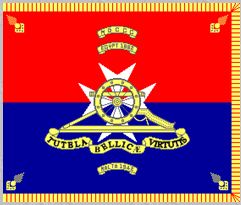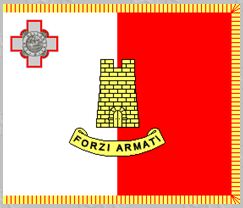Ceremonial Colours
The AFM has long had a strong artillery tradition and although the artillery in the British tradition don’t carry ceremonial flags – yet it now has an infantry regiment, complete with a National and a Regimental Colour, the latter featuring a whole array of artillery-related emblems!

Commander
This is a Red triangular pennant with golden emblem of the Armed Forces. The emblem is a mason tower of de Redin, which represents fortification and Malta defences back to the time of the knights of St. John’s.
AFM Colour
The AFM Colour of the Armed Forces of Malta is an oddity amongst military flags within the British tradition. This infantry colour bears the symbols of artillery, which normally would carry no ceremonial flags.
Specifically, it is a red-above-blue bicolour, bearing at the centre the badge of the Royal Malta Artillery (minus Royal Crown), which is the main predecessor of the modern-day Armed Forces of Malta; the motto “TUTELA BELLICAE VIRTUTIS” means “Custodians of Military Prowess”. The four corners bear the seven-flamed grenade above the scroll reading “MALTA”, tilted 45 degrees.
Currently it carries three battle honours on scrolls, from top to bottom: “MDCCC” (Siege of Valetta 1800); “EGYPT 1882”; and (below the motto) “MALTA 1942”. All emblems are in gold, with the exception of the Maltese Cross of the RMA badge, which is white. Red sleeve; golden fringe, cord and tassels; black pole with a silver finial in the form of a hollowed spearhead bearing a Maltese Cross.

Presidential Colour
The Armed Forces of Malta’s Presidential Colour is the National Flag with a yellow de Redin Tower at the centre, above a yellow scroll reading “FORZI ARMATI”. Red sleeve; golden fringe, cord and tassels; black pole with a silver finial in the form of a hollowed spearhead bearing a Maltese Cross.
History – Symbol of Identification
Colours are regarded as the conceptual personification of regimental spirit, a focal and rallying point on the battlefield to bedefended at all costs. This may seem to be an anachronistic description of what they signify to men and women serving in uniform today, where Colours are mainly used for ceremonial duties. Yet, the Colours continue to be venerated with the same passion by military forces around the world as when they served their purpose on the battlefield.
A Royal Warrant issued in September 1743 decreed that regiments were to carry two Colours; the Sovereign Colour and the Regimental Colour. The Sovereign Colour symbolised loyalty to the Crown, the Regimental Colour, the duty owed by its members to the regiment and its traditions. Commanders used the colours to judge the course of battle, while soldiers were provided with a concentration point to gather around and an irresistible exhortation to “stand firm”. However, due to changes in infantry tactics, dictated by the use of weapons with longer range, British Army regiments no longer carried Colours in battle after the Boer War.
The Colours of the Royal Regiment of Artillery are its guns. Until the end of the 18th century it was customary to fly a flag above the largest piece of an artillery train. This gun was designated the “Flag Gun. “After this period, the guns themselves came to be regarded as the Colours of the artillery and on parade on ceremonial occasions the guns are accorded the same compliments.

The history of the Colours used by Maltese Regiments during their connections with the British Army dates back to the very beginning of the British presence in Malta. During the last stages of the siege mounted by the Maltese against the French in 1800, the British raised a Maltese Light Infantry Regiment. This regiment was presented with its Colours the same year.
Other Maltese regiments to be presented with Colours included The Royal Regiment of Malta in 1807, which Colours saw active service in Capri. The same regiment was presented with a second set in 1809.The Royal Malta Fencible Regiment was presented with two sets of Colours in 1838 and 1859.
A development that left its mark on the future use of Flag Colours by Maltese Regiments was a decision by King William IV, who, in 1833, designated in-service guns as Colours. Therefore, when by General Order No 1 of January 25, 1861, the Royal Malta Fencible Regiment was converted from an infantry into an artillery corps and consequently renamed The Royal Malta Fencible Artillery, the Colours were laid up and deposited in the Armoury of the Governors’ Palace in Valletta. This order also applied to the Royal Malta Artillery (RMA) that came into being in 1897.
However, infantry regiments continued to carry Colours. The 1st Battalion, The Royal Regiment of Militia, was presented with Colours by Lady Fremantle in 1895 whilst the 2nd Battalion received its Colours in 1899 from Governor Lord Grenfell.
The King’s Own Malta Regiment (KOMR) was also an infantry regiment that was constituted in 1903 and presented with its first set of Colours in 1935 by Governor, General Sir David Campbell.
With the granting of Independence to Malta in 1964, Maltese regiments went through a number of significant changes. The Maltese government assumed responsibility for the Malta Territorial Force in 1965, then consisting of three territorial regiments, and subsequently on October 1, 1970, for the RMA. The Malta Land Force retained its gunner regimental traditions, dress and music and thus carried no Colours. In the case of the KOMR(T), the achievement of Maltese sovereignty was reflected in the last set of Colours presented to the Regiment by the Queen on November 15, 1967, whereby the Maltese flag replaced the Union Jack as the Sovereign’s Colour.
The MLF was renamed Armed Forces of Malta in 1973 but it was only with the formation of the Armed Forces of Malta Task Force that Colours were again presented to a Maltese military corps, this time by President Anton Buttigieg, on March 29, 1981. The Task Force Colours consisted of the National Colour which replaced that of the Sovereign, and the regimental Colour, claret in colour with the Task Force emblem in gold emblazoned in the centre incorporating a wing, an anchor and a rifle, representing the three major components of the Force.
The amalgamation of the Armed Forces of Malta and the Task Force on May 11, 1988 prompted the government to present the Armed Forces with a new set of Colours in June of the same year. The new Colours represent the reality of the Armed Forces of Malta today; a Force proud to belong to an independent state but nevertheless cherishing its roots and glorious past.
The National Colour consists of the Maltese flag with the De Redin Tower superimposed at the centre with, at its base, a scroll with the words Forzi Armati.
The Regimental Colour on the other hand, bears witness to the roots of the AFM, i.e. the Royal Malta Artillery. In fact, the RMA badge (exclusive of the Royal Crown) complete with the regiment’s motto ‘Tutela Bellicae Virtutis’ (Custodians of Military Prowess) stands emblazoned in the centre over the traditional Royal Malta Artillery colours of red and blue.
Three battle honours embellish the Colour. Battle honour MDCCC honours the Maltese Light Infantry for the siege of Valletta in 1800 whilst Egypt 1882 was awarded to the Malta Fencible Artillery Regiment for the high level of efficiency achieved throughout the expedition in Egypt. Malta 1942 is a battle honour assumed from the King’s Own Malta Regiment. The grenade of seven flames with the scroll ‘Malta’ is placed at the four corners of the Colour.
Since their presentation in 1988, the Colours of the Armed Forces of Malta have witnessed some of the most significant events in the Maltese nation’s life including the1989 Bush-Gorbachev Malta Summit, as well as official visits by the Pope and numerous heads of state.

